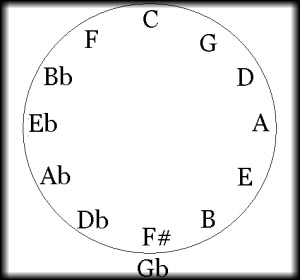Interpretation
Relative major and relative minor… Chord progressions
It is important to be able to extract as much relevant information as possible from a SeeChord chart. There are a few important patterns that consistantly appear for reasons that may not at first be obvious. Let’s dive into a bit of light music theory to help explain why some patterns are more important than others.
Fifths
The musical interval of a fifth is extremely important in giving music its structure. At a basic level, if you play the note C, then G is said to be a fifth above it. Play C and G together and you are playing a fifth, with C as the root note.
If you keep going up in fifths from a note, you will go through all 12 notes in music before arriving back at C again. This pattern is often represented as a circle of fifths:

Circle of fifths
SeeChord takes this pattern and places it vertically along the y-axis on the left hand side of the chart. The reason that these chords are placed together is that now, chords that are closely related are close together in the chart.
To see the consequences of this, let us have a look at some Classical music in a SeeChord chart. After all, many of the so called “rules” of harmony were defined hundreds of years ago when Classical music was developing.
[seeChordViewer src=”/content/Application/Interpretation/interpretation1-viewer”]
This is an extract from the beginning of J.S.Bach’s first prelude from book 1 of The Well Tempered Clavier. It is an ideal demonstration of the most common pattern that we see when using SeeChord charts.
The most important feature is that the music tends to fall in fifths as seen by the gently sloping downward lines. Clearly the music cannot fall in fifths continuously so it has to “jump” back up as can be seen by the steeper ascending lines. These jumps usually follow predictable patterns also as will be explained later. This example contains a “modulation” or change of key which can be seen by the filled in black square representing G major at the end of the extract. It is now possible to see how this key change has been handled by Bach.